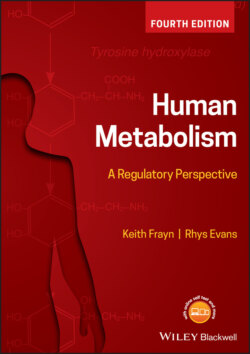Читать книгу Human Metabolism - Keith N. Frayn - Страница 42
1.3.3.2 Fat deposition and mobilisation
ОглавлениеMost dietary fat is in the form of triacylglycerol (Table 4.1). Within the small intestine, dietary triacylglycerol molecules are hydrolysed by intestinal lipases and the products are absorbed into the cells lining the intestines (mucosal or epithelial cells, collectively known as enterocytes). The products of lipolysis are recombined with the enterocytes to form new triacylglycerol. These triacylglycerols, composed of dietary fat, are liberated into the circulation as lipoprotein particles: in fact, the largest and most fat-enriched of the lipoprotein particles, known as chylomicrons (more detail in Chapters 4 and 10). At target tissues, the triacylglycerol in the lipoprotein particles is hydrolysed by a lipase bound to the endothelial cells lining the capillaries, known as lipoprotein lipase. The resulting fatty acids are taken up by cells, and have two potential fates: (i) re-esterification with glycerol 3-phosphate to make new triacylglycerol (and other lipids) – the pathway of fat deposition; or (ii) oxidation. The former is the major route by which dietary fat is laid down for storage in adipose tissue (Figure 1.17; Section 5.2.2.1).
When the stored fat is required as a source of energy, for instance during physical activity when muscles will oxidise fatty acids, or during periods between meals, then the stored triacylglycerol is hydrolysed by a series of intracellular lipases to liberate fatty acids and glycerol, which can be released into the plasma. This is the process known as fat mobilisation. As noted earlier, these non-esterified (‘free’) fatty acids are transported bound to albumin. Glycerol, which is freely soluble, will travel mainly to the liver where it is a substrate for gluconeogenesis as described above (Section 1.3.2.1.5). On average, in a mature adult who is weight-stable, the amount of fat stored in a typical day will equal the amount mobilised. Most tissues can utilise NEFAs, but importantly fatty acids cannot cross the blood-brain barrier and therefore cannot be used as an energy source by the central nervous system. Also, their oxidation requires mitochondria, meaning that red blood cells (erythrocytes), which lack mitochondria, are unable to use them. However, fatty acids are a major fuel source for muscle and kidney, and for the heart and liver under certain conditions.
